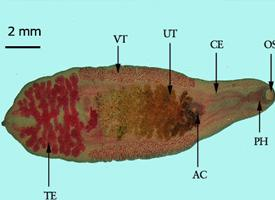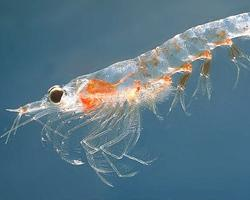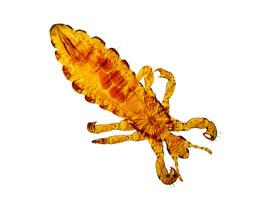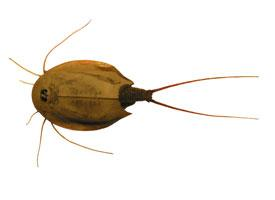
Données biologiques
| Durée de vie | de 15 à 20 ans |
|---|
Statut de conservation
| Intrépide |
Description de l'animal
The Chinese liver fluke, scientifically known as Clonorchis sinensis, is a parasitic flatworm belonging to the class Trematoda within the phylum Platyhelminthes. It is predominantly found in the liver of various mammals, including humans, where it can cause a significant parasitic disease known as clonorchiasis. This disease is most commonly encountered in East Asia, particularly in countries like China, Korea, Taiwan, and Vietnam, where the consumption of raw or undercooked freshwater fish, a primary vector for the fluke, is a common dietary practice.Morphologically, C. sinensis is a leaf-shaped fluke, typically measuring 10 to 25 mm in length and 3 to 5 mm in width, making it one of the medium-sized liver flukes. Its body is slender and slightly transparent, allowing for the visualization of internal structures under a microscope. The fluke possesses a complex digestive system starting with an oral sucker surrounding the mouth, which leads to a pharynx and then divides into two branched intestines extending towards the posterior end. This anatomical structure is crucial for its survival, as it allows the fluke to absorb nutrients from the bile and liver tissues of its host.
Reproduction in C. sinensis is exclusively sexual, occurring within the mammalian host. The fluke is hermaphroditic, possessing both male and female reproductive organs. After mating, which can be self-fertilization or cross-fertilization, the fluke lays eggs that are excreted by the host through feces. Once in a freshwater environment, these eggs hatch into free-swimming larvae, known as miracidia, which then infect specific species of freshwater snails, serving as the first intermediate host. Within the snail, the miracidia undergo several developmental stages, eventually transforming into another larval form called cercariae. These cercariae are released into the water and must find and penetrate a suitable freshwater fish to continue their life cycle. Within the fish, cercariae encyst as metacercariae in the flesh or skin, awaiting consumption by the definitive mammalian host, thus completing their complex life cycle.
Clonorchiasis, the disease caused by C. sinensis, is primarily a concern for liver health. In the early stages of infection, individuals may experience mild symptoms or none at all. However, with heavy or prolonged infection, symptoms can become more severe, including jaundice, abdominal pain, diarrhea, and in chronic cases, liver fibrosis, cholangiocarcinoma (bile duct cancer), and cirrhosis. The disease is diagnosed through microscopic examination of fecal samples for the presence of characteristic eggs, and it can be treated with specific anthelmintic medications.
The public health impact of C. sinensis is significant in endemic areas, prompting efforts for improved food safety practices, public health education, and environmental management to reduce the risk of infection. These efforts include promoting the thorough cooking of freshwater fish and the treatment of infected individuals to reduce the reservoir of infection.
Animaux similaires
Nouvelles photos d'animaux
Top 10 des animaux
- Dolphin gull (Leucophaeus scoresbii)
- Diana monkey (Cercopithecus diana)
- Moustached guenon (Cercopithecus cephus)
- Galápagos tortoise (Geochelone nigra complex)
- Russian tortoise (Testudo horsfieldii)
- Stone loach (Barbatula barbatula)
- Japanese macaque (Macaca fuscata)
- Greek tortoise (Testudo graeca)
- Common flying dragon (Draco volans)
- Vendace (Coregonus albula)


